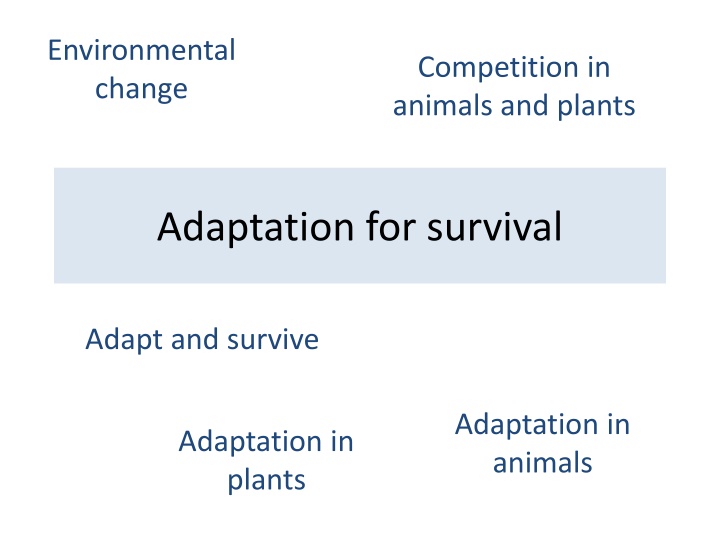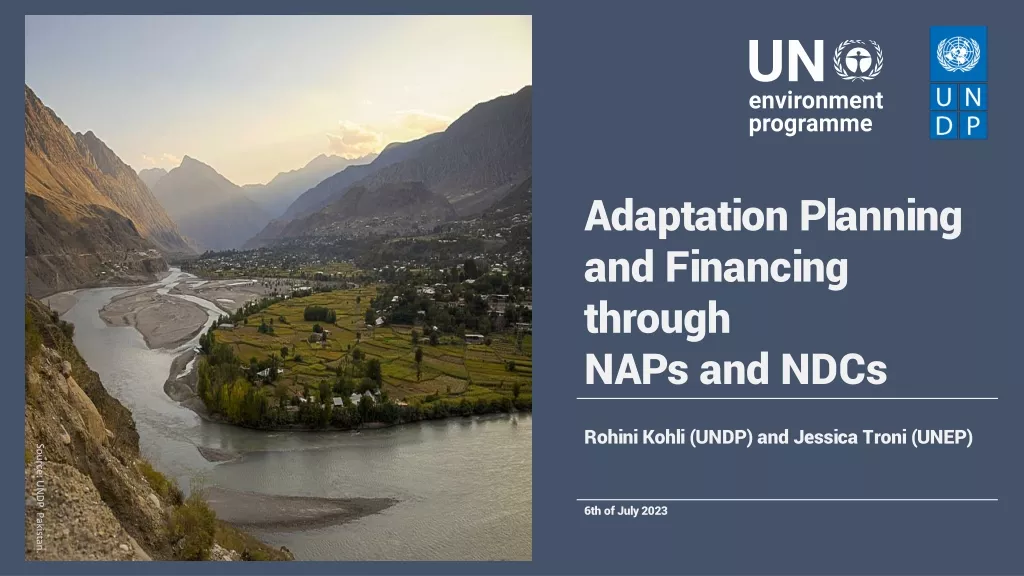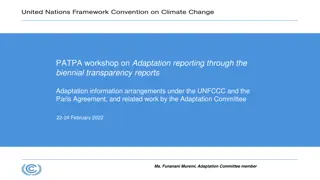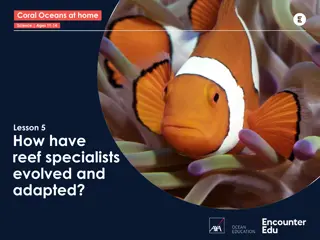
Adaptation Strategies in Animals and Plants for Survival in Changing Environments
Explore how animals and plants adapt to environmental changes through competition, survival strategies, and unique adaptations for thriving in different conditions. Discover the importance of adaptation for living organisms in various habitats.
Download Presentation

Please find below an Image/Link to download the presentation.
The content on the website is provided AS IS for your information and personal use only. It may not be sold, licensed, or shared on other websites without obtaining consent from the author. If you encounter any issues during the download, it is possible that the publisher has removed the file from their server.
You are allowed to download the files provided on this website for personal or commercial use, subject to the condition that they are used lawfully. All files are the property of their respective owners.
The content on the website is provided AS IS for your information and personal use only. It may not be sold, licensed, or shared on other websites without obtaining consent from the author.
E N D
Presentation Transcript
Environmental change Competition in animals and plants Adaptation for survival Adapt and survive Adaptation in animals Adaptation in plants
Adapt and survive Living organisms need to survive and reproduce Plantsneed: light, carbon dioxide, water, oxygen, nutrients Animalsneed: food, water, oxygen Microorganisms needs depend - some are light plants, some like animals and some need no oxygen or light Extremophiles organisms adapted to extreme environments. e.g. Bacteria can live at temperatures as low as -15 or up to 80C as their enzymes are adapted not to denature. How do you survive? Each fig tree has its own type of pollinating wasp the fig flowers are adapted to attract the specific wasp type. The wasps are adapted with specially shaped heads, ovipositors Star nose mole reacts and eats prey within 230milliseconds - they are blind and need to eat their prey as soon as they touch it or it might escape Venus fly traps have grow in bogs with little nutrients. Insects are attracted to their smell and colour, enzymes are digested and nutrients used
http://static.guim.co.uk/sys-images/Guardian/Pix/pictures/2008/10/19/seal10.jpghttp://static.guim.co.uk/sys-images/Guardian/Pix/pictures/2008/10/19/seal10.jpg Adaptation in animals Surface area: volume ratio Mammals in a cool climate grow to a large size (e.g. Whales) to keep their ratio as small as possible to maintain body heat Cold Climates: Small surface area e.g. Ears Insulation blubber (thick layer of fat under skin), fur coat Fat layer also provides a food supply during winter Dry climates Deserts may be hot in day and freezing at night. Lack of water Often active at night rather than day Can t sweat or will lose water small large surface area:volume to lose heat through skin Big ears- lose heat Thin fur, little body fat http://2.bp.blogspot.com/-rqGRyjuwxfc/TaLfx4AMMCI/AAAAAAAACOw/gRw8yk0H8zA/s1600/arctic_hare.171.jpg http://t0.gstatic.com/images?q=tbn:ANd9GcTN8cLxHP15OBiygJL9-pAbPCxFki8KN-2AyMOXqooHsMLIRFKNdA Camouflage : Important in predators and prey Dependent on environment (arctic hares brown in summer and white in winter)
Adaptation in plants Water taken in through roots Stoma in leaves allow gases in and out for photosynthesis and respiration Surface area:volume ratio Curled leaves traps layer of http://upload.wikimedia.org/wikipedia/commons/4/47/Ferocactus_schwarzii._Jard%C3%ADn_de_Cactus_-_Lanzarote_-_J08.jpg In dry climates: very wide root systems store water in leaves, stems or roots moist air, reduces surface area Thick cuticle stops evaporation Or.. Broad leaves large surface area to collect dew http://menorca-live.com/wp-content/uploads/2012/07/Cactus_plant.jpg Epiphytes in rainforests live high above ground and collect water and nutrients from the air
Competition in animals and plants Animals Food more likely to be successful if eat a wide range. Competition between own species too, better adapted will survive Territory compete for best space/ area Mate males fight or display Success depends on adaptations ... Avoiding competition can also lead to success Plants Light (photosynthesis) smaller plants may flower earlier in the year before the bigger plants to get more light Water (photosynthesis) different types of roots spread along surface or deep underground Nutrients Space (roots and light) Spreading seeds sycamore, dandelion, Fruits, sticky http://t3.gstatic.com/images?q=tbn:ANd9GcRHu59-Y9LGbXRjJR9tTUOqRQH2JdtIl0GHGlobiQE8eCyyg_m3 http://thegraphicsfairy.com/wp-content/uploads/blogger/-77Vd3Gq7N2k/TX6Y317Jg2I/AAAAAAAALSA/nCpQeyCd8yE/s1600/peacock-vintage-graphicsfairy001c.jpg http://t2.gstatic.com/images?q=tbn:ANd9GcSr0hmaaHNG95Mi6gZaLW-uI2yYSK5oRsdVanfJ65RXE3Kr5ula http://t1.gstatic.com/images?q=tbn:ANd9GcTkRfeivLjC6C4jNxEhpsCkIWdP-pRn2vYuFkfRqwu6954P-rxu
Environmental change Average temperature, wind, rainfall, light, pH, oxygen levels, other species, climate will affect where an organism lives If any of these change the biodiversity can be affected Bioindicators can be used to monitor change lichen are sensitive to air pollution http://upload.wikimedia.org/wikipedia/commons/8/8c/Flavoparmelia_caperata_-_lichen_-_Caperatflechte.jpg Changing birds of Britain Bird habitats and migration affected Dartford warblers are more common due to increased temperatures, but less common in Spain where it is now too warm Bees Disease (CCD) affecting honey bees Bees are important for pollination of plants apples, raspberries, cucumbers etc Cause unknown pesticides? Climate? http://shropshirebirder.co.uk/gallery/Dartford%20Warbler%20Arne%208%205%2010%20IMG_6675_filtered.jpg http://www.warrenphotographic.co.uk/photography/bigs/01312-Honey-Bee-from-above-white-background.jpg http://upload.wikimedia.org/wikipedia/commons/7/7a/Honey_bee_on_a_dandelion,_Sandy,_Bedfordshire_(7002893894).jpg






















